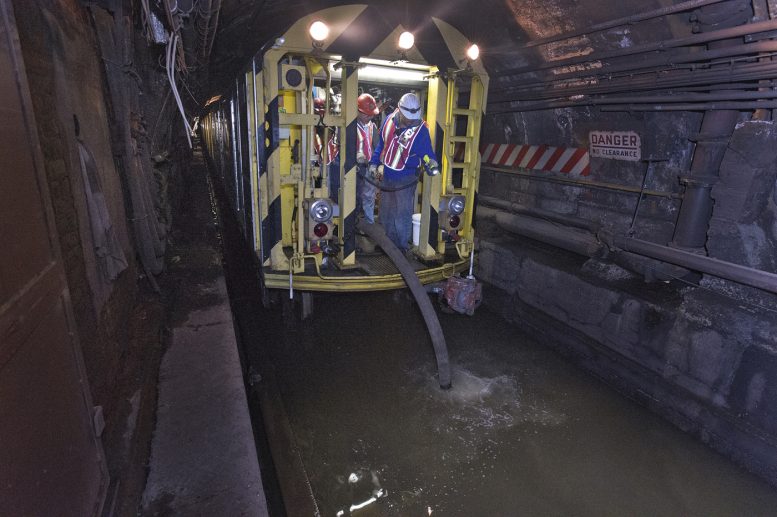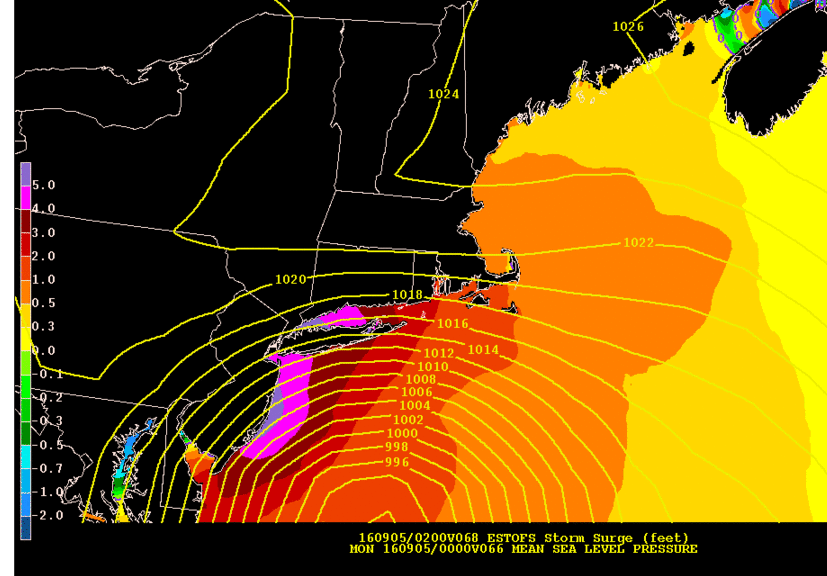New York City has long dealt with storms, but recently, things have been getting more turbulent. In 2011, Hurricane Irene almost flooded the subways; the city’s sigh of relief was quickly suffocated by Sandy only one year later, which wrecked much of the system. This past winter, while Delaware and southern New Jersey were again hit by record tides during Central Park’s heaviest-ever snowstorm, the city escaped relatively unscathed. But, on Sunday, New Yorkers may not be so lucky, as guidance from NOAA’s storm surge model shows a substantial storm surge into the city, which would approach the tipping point for flooding of underground infrastructure.
This is problematic for several reasons, but the most glaringly obvious is that Sandy’s repairs have not yet been completed. In fact, the L Train — despite all it has already been through — is still set to partially shutter for 18 months starting in 2019, to repair damage for a storm that will, at that point, have occurred seven years prior.
While the forecast for Sunday could easily change quite dramatically, the increasing consensus from several models and the National Hurricane Center paints a potentially grim picture for the city’s future. Indeed, it seems to illustrate the fact that infrastructure repairs have largely been conducted without anything beyond token recognition of the continued threat the city has faced since Sandy.
A recent feature by Wired profiled the MTA’s efforts to stop flooding, and while some of the ideas seem promising, there are several shortfalls. The most pertinent to the city’s current situation is the fact that only fourteen new inflatable flood protectors (however reliable they may be) have so far been installed, while the city is awaiting another fifty by the end of the year. That math clearly indicates that much of New York’s infrastructure remains as vulnerable now as it did the day Sandy came ashore.
Much of this boils down to problems associated with the subway’s age, as large portions have been in use for over a century, and were built without thought to the potential of future sea level rise and subsequent flooding. Unfortunately, even today, our infrastructure priorities ignore this reality, as a $4.2 billion splurge on La Guardia Airport is met without questioning how the airport will deal with being consumed by Flushing Bay (beyond $28 million for token renovations to protect the electrical substation).
Whether Hermine impacts New York City or not, the city is contending with increasingly regular threats to its underground and coastal infrastructure, yet efforts to mitigate future damage have so far been minimal. Besides the new blow-up barriers, the city has dawdled on a coastal defense plan with lots of renderings but little practicality, as another smaller but more ambitious scheme created during the Bloomberg years has sat on the sidelines for the east side of Lower Manhattan.
With infrastructure projects across the metropolitan region costing more than anywhere else on the planet, it is especially surprising that the locations selected for work have substantial risk to increasing sea levels. If the exorbitant costs for construction and nonsensical choice of projects are viewed alongside the state’s recent tiff with Mayor Bill de Blasio, it begins to look like soaring labor costs are creating grosser inefficiencies across all aspects of the city’s infrastructure planning.
Unfortunately, the combination of these factors with increasingly frequent pulses of saltwater into the subways is going to leave New York City paralyzed from the bottom-up. The exact solution is unclear, but Bloomberg’s plan for Seaport City would have provided a blueprint for creating new land and more housing. Following the lead of Battery Park City, it is also much easier to construct new infrastructure atop raw land than it is to work with the city’s existing fabric, and new real estate behind any kind of seawall would allow private entities to foot part of the bill through additional development (while also helping the city’s housing crisis).
Tackling sea level rise can be a win-win for New Yorkers if infrastructure spending can somehow be put into check. But until that happens, the minimal changes since Sandy seem insufficient to prepare for what’s projected in the near future, and fantastical visions for conceptually unobtrusive flood barriers have remained just that. While the next potential threat to the city’s infrastructure churns down south, the L Train is creaking along, still awaiting additional repairs to existing damage that are three years away.
Subscribe to YIMBY’s daily e-mail
Follow YIMBYgram for real-time photo updates
Like YIMBY on Facebook
Follow YIMBY’s Twitter for the latest in YIMBYnews




All this while Trump, Republi-cants, and conservatives deny climate change in order to “protect” business interests. Some “protection” – when we’ll all sufffer unless we act.
This whole story seems suspect. Featuring a picture of about a foot of water in some unidentified tunnel [is it the L?] – with no date – to represent Sandy’s worst. The photo seems to undermine the very premise of the article. It seems VERY unlikely that a foot of brackish – not salt water – in the tunnel for a couple days years ago would do enough damage to require closing the tunnels for 2 years.
Many people suspect the proposal to close the L train is an attempt to drive demand out of North Brooklyn towards Hudson Yards, the 7 train and Manhattan generally.
Some concerned citizens point out that the Hudson Yards lease out timeline aligns exactly with the L train closure dates. Which is interesting in itself.
Elected officials and citizens affiliated with the L Train Coalition are calling for an impartial audit of the MTA’s findings and scope of work for the tunnels.
The L train has been running fine since Sandy – it may need some work but that work would not require shutting the line for 2 years..
Nothing that you say is true. The 14th Street tunnel was completely submerged in brackish water containing significant amounts of salt, not two feet of water. The infrastructure within the tunnel continues to deteriorate because of the time spent submerged, and it must be replaced. The MTA has presented clear and convincing evidence of this. Spreading paranoid false rumors does no one any good. The work must be done and has nothing to do with Hudson Yards.
The storm made a lot of inconvenience for New Yorkers, city want more safety because bad weather is increasing.
pathetic .. It will effect in the shore , Shore of Brooklyn , Queens , Long Island. It will not effect Manhattan , Bronx . Only Brooklyn , Queens Long Island… Manhattan , Bronx are in good shape….
This is a good summary of the underlying problems, but not of the long term perspective. Gavin Schmidt of NASA:
https://www.thecipherbrief.com/article/middle-east/record-breaking-heat-1095
I think if Williamsburg citizens are concerned then the MTA should provide a modicum of evidence of this “continued deterioration” that requires shutdown! Work should be done on weekends and in the evening to repair damage like all of the other lines!!!